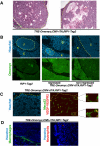Endogenous Myc maintains the tumor microenvironment
- PMID: 21478273
- PMCID: PMC3084025
- DOI: 10.1101/gad.2038411
Endogenous Myc maintains the tumor microenvironment
Abstract
The ubiquitous deregulation of Myc in human cancers makes it an intriguing therapeutic target, a notion supported by recent studies in Ras-driven lung tumors showing that inhibiting endogenous Myc triggers ubiquitous tumor regression. However, neither the therapeutic mechanism nor the applicability of Myc inhibition to other tumor types driven by other oncogenic mechanisms is established. Here, we show that inhibition of endogenous Myc also triggers ubiquitous regression of tumors in a simian virus 40 (SV40)-driven pancreatic islet tumor model. Such regression is presaged by collapse of the tumor microenvironment and involution of tumor vasculature. Hence, in addition to its diverse intracellular roles, endogenous Myc serves an essential and nonredundant role in coupling diverse intracellular oncogenic pathways to the tumor microenvironment, further bolstering its credentials as a pharmacological target.
Figures









Comment in
-
Tumour microenvironment: target practice.Nat Rev Cancer. 2011 May;11(5):315. doi: 10.1038/nrc3058. Nat Rev Cancer. 2011. PMID: 21508969 No abstract available.
-
Addicted to Myc--but why?Genes Dev. 2011 May 1;25(9):895-7. doi: 10.1101/gad.2053311. Genes Dev. 2011. PMID: 21536730 Free PMC article.
References
-
- Ahuja D, Saenz-Robles MT, Pipas JM 2005. SV40 large T antigen targets multiple cellular pathways to elicit cellular transformation. Oncogene 24: 7729–7745 - PubMed
-
- Brekken RA, Huang X, King SW, Thorpe PE 1998. Vascular endothelial growth factor as a marker of tumor endothelium. Cancer Res 58: 1952–1959 - PubMed
Publication types
MeSH terms
Substances
Grants and funding
LinkOut - more resources
Full Text Sources
Other Literature Sources
Molecular Biology Databases
